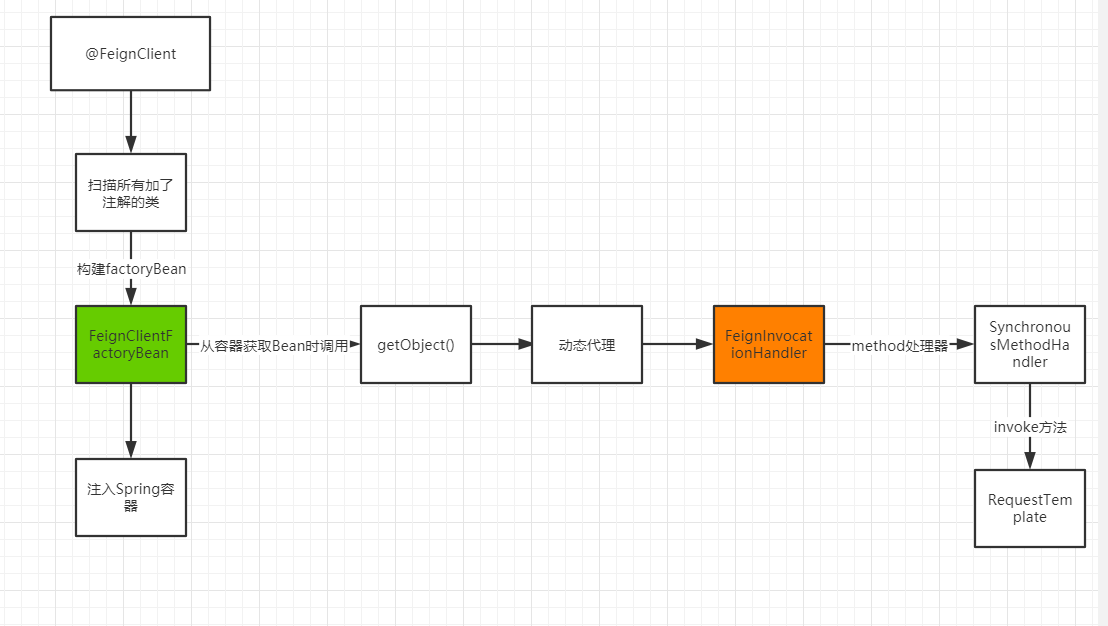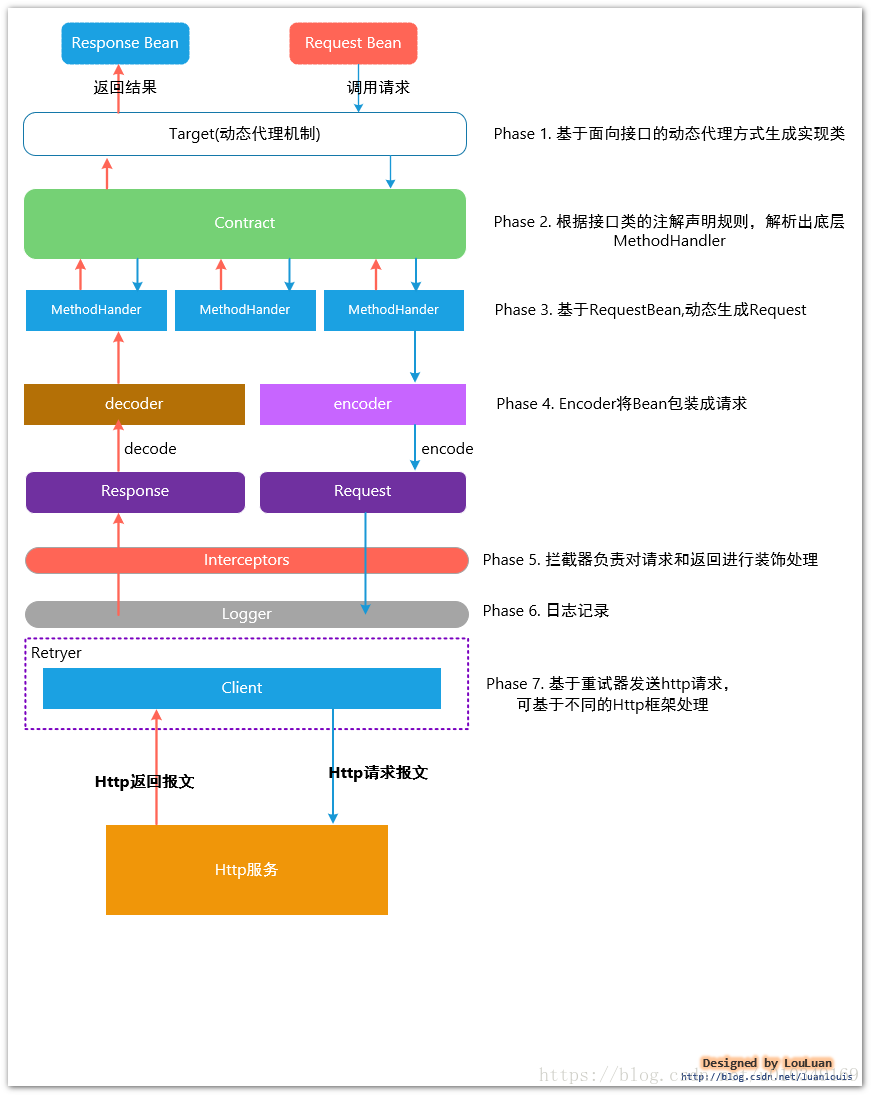一、主线流程
先上一个Feign示例代码:
@FeignClient(value = "study-user",path = "/user",fallback =UserApiFallBack.class)
public interface UserApi {
@RequestMapping(value = "/getUserById",method = RequestMethod.GET)
User getUserById(@RequestParam(name = "id") Integer id);
}
先来个主线流程图:

文字描述:FeignClientsRegistrar这个类会将加了@FeignClient注解的接口实例化一个对象注入到Spring容器中,这个对象是个代理对象,也就是FeignInvocationHandler,里面的每个我们写的方法会经过SynchronousMethodHandler这个处理器处理,将他转为使用http发送请求的方式来执行方法。对应上面的示例代码,它会将我们写的User getUserById(@RequestParam(name = "id") Integer id);方法转为http方式调用http://study-user/getUserById
二、代码细节
了解了大概流程后,再来看看具体的代码吧!!!
- 说起Feign的使用,我们得从他的启用注解说起,也就是@EnableFeignClients
@SpringBootApplication
@EnableFeignClients
public class UserApplication {
public static void main(String[] args) {
SpringApplication.run(UserApplication.class);
}
}
- @EnableFeignClients注解的里面是如下注解
@Retention(RetentionPolicy.RUNTIME)
@Target(ElementType.TYPE)
@Documented
@Import(FeignClientsRegistrar.class)
public @interface EnableFeignClients {
- 所以我们需要分析FeignClientsRegistrar类,里面有一些重要的方法1如下:主要作用是扫描指定的包路径注册为FeignClient
public void registerFeignClients(AnnotationMetadata metadata,BeanDefinitionRegistry registry) {
ClassPathScanningCandidateComponentProvider scanner = getScanner();
scanner.setResourceLoader(this.resourceLoader);
Set<String> basePackages;
Map<String,Object> attrs = metadata
.getAnnotationAttributes(EnableFeignClients.class.getName());
AnnotationTypeFilter annotationTypeFilter = new AnnotationTypeFilter(
FeignClient.class);
final Class<?>[] clients = attrs == null ? null
: (Class<?>[]) attrs.get("clients");
if (clients == null || clients.length == 0) {
scanner.addIncludeFilter(annotationTypeFilter);
basePackages = getBasePackages(metadata);
}
else {
final Set<String> clientClasses = new HashSet<>();
basePackages = new HashSet<>();
for (Class<?> clazz : clients) {
basePackages.add(ClassUtils.getPackageName(clazz));
clientClasses.add(clazz.getCanonicalName());
}
AbstractClassTestingTypeFilter filter = new AbstractClassTestingTypeFilter() {
@Override
protected boolean match(ClassMetadata metadata) {
String cleaned = metadata.getClassName().replaceAll("\\$",".");
return clientClasses.contains(cleaned);
}
};
scanner.addIncludeFilter(
new AllTypeFilter(Arrays.asList(filter,annotationTypeFilter)));
}
for (String basePackage : basePackages) {
Set<BeanDefinition> candidateComponents = scanner
.findCandidateComponents(basePackage);
for (BeanDefinition candidateComponent : candidateComponents) {
if (candidateComponent instanceof AnnotatedBeanDefinition) {
// verify annotated class is an interface
AnnotatedBeanDefinition beanDefinition = (AnnotatedBeanDefinition) candidateComponent;
AnnotationMetadata annotationMetadata = beanDefinition.getMetadata();
Assert.isTrue(annotationMetadata.isInterface(),"@FeignClient can only be specified on an interface");
//获取注解的参数值
Map<String,Object> attributes = annotationMetadata
.getAnnotationAttributes(
FeignClient.class.getCanonicalName());
String name = getClientName(attributes);
registerClientConfiguration(registry,name,attributes.get("configuration"));
registerFeignClient(registry,annotationMetadata,attributes);
}
}
}
}
- 还有一个重要的方法registerFeignClient(),
private void registerFeignClient(BeanDefinitionRegistry registry,AnnotationMetadata annotationMetadata,Map<String,Object> attributes) {
//重点,构建一个FeignClientFactoryBean对象,这是一个代理对象
String className = annotationMetadata.getClassName();
BeanDefinitionBuilder definition = BeanDefinitionBuilder
.genericBeanDefinition(FeignClientFactoryBean.class);
validate(attributes);
//设置属性
definition.addPropertyValue("url",getUrl(attributes));
definition.addPropertyValue("path",getPath(attributes));
String name = getName(attributes);
definition.addPropertyValue("name",name);
definition.addPropertyValue("type",className);
definition.addPropertyValue("decode404",attributes.get("decode404"));
definition.addPropertyValue("fallback",attributes.get("fallback"));
definition.addPropertyValue("fallbackFactory",attributes.get("fallbackFactory"));
definition.setAutowireMode(AbstractBeanDefinition.AUTOWIRE_BY_TYPE);
String alias = name + "FeignClient";
AbstractBeanDefinition beanDefinition = definition.getBeanDefinition();
boolean primary = (Boolean)attributes.get("primary"); // has a default,won't be null
beanDefinition.setPrimary(primary);
String qualifier = getQualifier(attributes);
if (StringUtils.hasText(qualifier)) {
alias = qualifier;
}
BeanDefinitionHolder holder = new BeanDefinitionHolder(beanDefinition,className,new String[] { alias });
//注册为bean放入spring中
BeanDefinitionReaderUtils.registerBeanDefinition(holder,registry);
}
- 上面两个方法的主要作用就是根据注解的属性值构建一个FeignClientFactoryBean对象,他是一个FactoryBean对象,所以在获取bean的时候会执行他的getObject()方法。这个方法如下:
@Override
public Object getObject() throws Exception {
return getTarget();
}
/**
* @param <T> the target type of the Feign client
* @return a {@link Feign} client created with the specified data and the context information
*/
<T> T getTarget() {
FeignContext context = applicationContext.getBean(FeignContext.class);
Feign.Builder builder = feign(context);
if (!StringUtils.hasText(this.url)) {
String url;
//看到有http,说明Feign使用的http协议请求的
if (!this.name.startsWith("http")) {
url = "http://" + this.name;
}
else {
url = this.name;
}
url += cleanPath();
//所以Feign的底层也是使用loadBalance
return (T) loadBalance(builder,context,new HardCodedTarget<>(this.type,this.name,url));
}
if (StringUtils.hasText(this.url) && !this.url.startsWith("http")) {
this.url = "http://" + this.url;
}
String url = this.url + cleanPath();
Client client = getOptional(context,Client.class);
if (client != null) {
if (client instanceof LoadBalancerFeignClient) {
// not load balancing because we have a url,// but ribbon is on the classpath,so unwrap
client = ((LoadBalancerFeignClient)client).getDelegate();
}
builder.client(client);
}
//组装targer参数
Targeter targeter = get(context,Targeter.class);
return (T) targeter.target(this,builder,new HardCodedTarget<>(
this.type,url));
}
- 使用了loadBalance()方法构建返回了一个Target对象,然后调用target()方法,target方法里面通过Feign的Builder方式来设置属性,然后使用newInstance创建一个代理对象
@Override
public <T> T newInstance(Target<T> target) {
Map<String,MethodHandler> nameToHandler = targetToHandlersByName.apply(target);
Map<Method,MethodHandler> methodToHandler = new LinkedHashMap<Method,MethodHandler>();
List<DefaultMethodHandler> defaultMethodHandlers = new LinkedList<DefaultMethodHandler>();
for (Method method : target.type().getMethods()) {
if (method.getDeclaringClass() == Object.class) {
continue;
} else if(Util.isDefault(method)) {
DefaultMethodHandler handler = new DefaultMethodHandler(method);
defaultMethodHandlers.add(handler);
//放入了方法处理器,handler类型为SynchronousMethodHandler
methodToHandler.put(method,handler);
} else {
methodToHandler.put(method,nameToHandler.get(Feign.configKey(target.type(),method)));
}
}
//使用了动态代理,代理类FeignInvocationHandler
InvocationHandler handler = factory.create(target,methodToHandler);
T proxy = (T) Proxy.newProxyInstance(target.type().getClassLoader(),new Class<?>[]{target.type()},handler);
for(DefaultMethodHandler defaultMethodHandler : defaultMethodHandlers) {
defaultMethodHandler.bindTo(proxy);
}
return proxy;
}
- 熟悉动态代理的都知道,它实际是执行的里面的invoke方法,我们来看FeignInvocationHandler的invoke方法做了什么?
@Override
public Object invoke(Object proxy,Method method,Object[] args) throws Throwable {
if ("equals".equals(method.getName())) {
try {
Object
otherHandler =
args.length > 0 && args[0] != null ? Proxy.getInvocationHandler(args[0]) : null;
return equals(otherHandler);
} catch (IllegalArgumentException e) {
return false;
}
} else if ("hashCode".equals(method.getName())) {
return hashCode();
} else if ("toString".equals(method.getName())) {
return toString();
}
//重点是这行,dispatch.get(method)获取到的就是之前放入的SynchronousMethodHandler方法,他会执行
return dispatch.get(method).invoke(args);
}
- 再看看SynchronousMethodHandler里的invoke方法
public Object invoke(Object[] argv) throws Throwable {
RequestTemplate template = buildTemplateFromArgs.create(argv);
Retryer retryer = this.retryer.clone();
while (true) {
try {
//编解码并执行
return executeAndDecode(template);
} catch (RetryableException e) {
retryer.continueOrPropagate(e);
if (logLevel != Logger.Level.NONE) {
logger.logRetry(metadata.configKey(),logLevel);
}
continue;
}
}
}
- executeAndDecode()方法,看到这个方法就明白原理了。里面包含了日志,编解码,http请求
Object executeAndDecode(RequestTemplate template) throws Throwable {
Request request = targetRequest(template);
if (logLevel != Logger.Level.NONE) {
logger.logRequest(metadata.configKey(),logLevel,request);
}
Response response;
long start = System.nanoTime();
try {
response = client.execute(request,options);
// ensure the request is set. TODO: remove in Feign 10
response.toBuilder().request(request).build();
} catch (IOException e) {
if (logLevel != Logger.Level.NONE) {
logger.logIOException(metadata.configKey(),e,elapsedTime(start));
}
throw errorExecuting(request,e);
}
long elapsedTime = TimeUnit.NANOSECONDS.toMillis(System.nanoTime() - start);
boolean shouldClose = true;
try {
if (logLevel != Logger.Level.NONE) {
response =
logger.logAndRebufferResponse(metadata.configKey(),response,elapsedTime);
// ensure the request is set. TODO: remove in Feign 10
response.toBuilder().request(request).build();
}
if (Response.class == metadata.returnType()) {
if (response.body() == null) {
return response;
}
if (response.body().length() == null ||
response.body().length() > MAX_RESPONSE_BUFFER_SIZE) {
shouldClose = false;
return response;
}
// Ensure the response body is disconnected
byte[] bodyData = Util.toByteArray(response.body().asInputStream());
return response.toBuilder().body(bodyData).build();
}
if (response.status() >= 200 && response.status() < 300) {
if (void.class == metadata.returnType()) {
return null;
} else {
Object result = decode(response);
shouldClose = closeAfterDecode;
return result;
}
} else if (decode404 && response.status() == 404 && void.class != metadata.returnType()) {
Object result = decode(response);
shouldClose = closeAfterDecode;
return result;
} else {
throw errorDecoder.decode(metadata.configKey(),response);
}
} catch (IOException e) {
if (logLevel != Logger.Level.NONE) {
logger.logIOException(metadata.configKey(),elapsedTime);
}
throw errorReading(request,e);
} finally {
if (shouldClose) {
ensureClosed(response.body());
}
}
}
- 最终再附一张网上描述流程的图来作为总结,从调用请求到返回结果的一个设计图

原文地址:https://www.cnblogs.com/javammc
版权声明:本文内容由互联网用户自发贡献,该文观点与技术仅代表作者本人。本站仅提供信息存储空间服务,不拥有所有权,不承担相关法律责任。如发现本站有涉嫌侵权/违法违规的内容, 请发送邮件至 dio@foxmail.com 举报,一经查实,本站将立刻删除。

